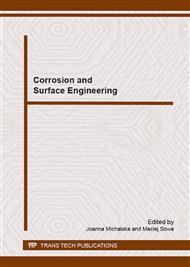p.443
p.447
p.451
p.455
p.459
p.463
p.467
p.471
p.475
Improvement of the Corrosion Resistance of Biomedical Magnesium Alloys in the Ringer’s Solution Using Protective Coatings
Abstract:
The corrosion resistance of magnesium alloys depends on their microstructure, especially the presence of different intermetallic phases and precipitates. In this paper, the electrochemical behaviour of Mg1Ca and Mg1Ca1Si magnesium alloys has been investigated in the Ringer’s solution at 37 °C. In order to improve the corrosion resistance of these magnesium alloys composite coatings were fabricated by modification of a chitosan layer. The coatings were prepared by dip-coating in a chitosan solution and then modified by electrochemical deposition of a layer from a solution containing fluorine ions and water glass. The electrochemical performance of chitosan and chitosan modified coated alloys was evaluated by linear sweep voltamperometry and electrochemical impedance spectroscopy. The coated magnesium alloys possess suitable corrosion behaviour for the application as biodegradable implant material.
Info:
Periodical:
Pages:
459-462
Citation:
Online since:
January 2015
Authors:
Keywords:
Price:
Сopyright:
© 2015 Trans Tech Publications Ltd. All Rights Reserved
Share:
Citation:


